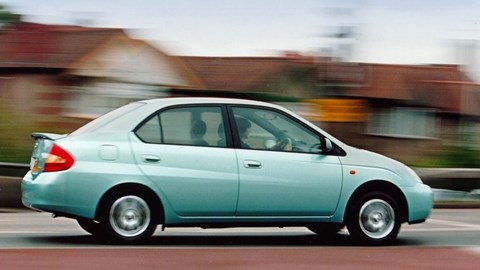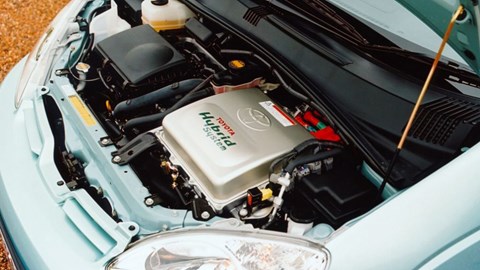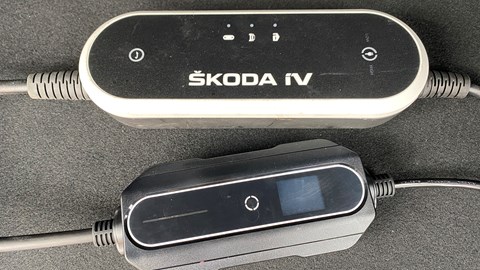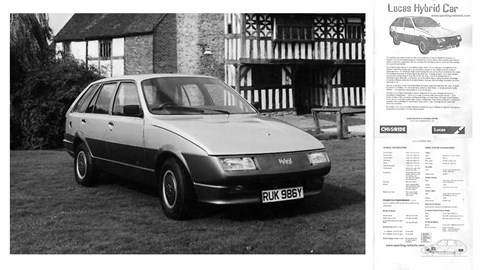► How to buy a used hybrid car
► Benefits include great mpg and reliability
► Different hybrid tech explained
Hybrid cars, which combine combustion engines with electric motor assistance, were originally developed as a means of reducing emissions and increasing fuel economy. This, and the resulting tax breaks, has always made them attractive as new cars – you can find our list of the best new hybrids here – but if you’re buying a used hybrid you’re probably at least as worried about reliability and cost. Our used hybrid car buying guide is here to help.
On this page we’ll take you through the pros and cons of a second-hand hybrid car, explain the three main hybrid technologies, and give you some pointers about what to look for when searching for your perfect match. Things have come on a long way since the original Toyota Prius, and the good news is a decent used hybrid will now give you economy nearly equivalent to a modern diesel with the promise of much greater reliability.
Different types of used hybrid car explained
Hybrid car technology arrived in 1998, when Toyota introduced the first-generation Prius, a series-hybrid ‘self-charging’ vehicle. Initial sales in Japan were soon expanded, and in America the Prius became the ultimate virtue signal for Hollywood celebs, lampooned in South Park. In the UK, the signal usually read ‘For Hire’, as the benefits of electric motors in crawling city traffic (plus tax incentives, of course) were obvious for taxi and delivery drivers.
Now there are three types of hybrid car to choose from: self-charging, plug-in hybrid and mild hybrid.
Self-charging hybrids generally follow Toyota’s original concept of electric motor turning the wheels as much as possible, using the petrol engine as a generator or at higher speeds, and relying on only a small-capacity drive battery. These can typically achieve little more than a mile on the electric motor in one go, but as the tech has matured the best self-charging hybrids will now regenerate their batteries so effectively they can switch to electric power much more frequently. Meaning a surprisingly high-percentage of any given journey will be combustion-free.

The plug-in hybrid electric vehicle, made popular by the Mitsubishi Outlander PHEV introduced in 2013, uses a larger battery for longer-range electric-only operation, often providing more power for all-wheel drive or performance options. Many will achieve over 20 miles of EV range even in winter – with the latest models capable of over 50 miles – and they can usually reach motorway speeds without troubling the engine when charged up.
The best plug-in hybrids will deliver very high fuel economy if you’re able to charge them regularly, since many journeys can be completed without using petrol (or less commonly, diesel) at all. They aren’t so sensible if you don’t charge them, though, as you end up carrying additional weight around for no benefit.
Finally the most recently introduced mild hybrid electric vehicle (mHEV) beefs-up the starter-generator concept used by stop-start systems and gives it a small battery pack to provide a variety of efficiency measures. It’s the loosest definition of hybrid, and the abilities of cars marketed as mHEV can vary wildly. Only very few of them can move the car on electric power alone, and then only at very low speeds. Most use the system to shut the engine down more often – saving more fuel when slowing or coasting – or to provide a modest torque boost when accelerating.
Compared to a self-charging hybrid even the best mild hybrid cars will only offer small fuel savings, though they are typically more refined and nicer to drive than non mHEV combustion equivalents.
Read to the end for a little more hybrid history, if you’re interested in knowing how close Britain came to pioneering this tech.
How much does a used hybrid car cost?
There are second hand hybrid cars for most lifestyles and needs, with prices for good examples starting from around £4000.
Spend around £12,000 and you’ll find nicer examples, and if you’re considering a used larger car instead of a new supermini, the £20,000 cost of a typical new entry-level car will get a recent, lower-mileage hybrid in most shapes and sizes.
Should I buy a used hybrid car?
Reasons to choose a hybrid can vary, but with low official CO2 ratings they are more compatible with clean air zones in city centres and they genuinely deliver high average fuel economy in urban driving. The stop-start nature of city traffic plays to all hybrid strengths, allowing them to make maximum use of the batteries and electric motors.
Drivers with an automatic licence benefit from the hybrid car as well: with the exception of mild hybrids, nearly all are two-pedal with an automatic transmission and unlike older, cheap conventional automatics, are generally very reliable.
That reliability and longevity also brings in the other reason to look at a hybrid car – it’s the sensible choice over a tired premium diesel. Few of the problems that blight the black pump’s followers will crop up on electrified petrol cars – issues with AdBlue, particulate filters, hammered dual-mass flywheels and grimy, grubby, sludge-prone oil are all eliminated simply by option for a petrol electric hybrid, yet fuel economy in many situations will be at least as good as a diesel.
Features such as regenerative braking also prolong the life of consumables such as tyres and brake pads, while wear and tear on mounts, transmission and other components is generally mitigated by the heavy-handed engine management behind the drive-by-wire accelerator. In short, most hybrids are inherently built to shield the running gear from the most aggressive and ham-fisted of previous owners.
So your careful, considerate stewardship will give any used hybrid you choose a very long life, of course…
What sort of hybrid car should I buy?
Before shopping for a hybrid car, make sure the technology meets your needs. If you want better fuel economy, but can’t plug the car in to charge up at home or work, there’s no real benefit in public charging and a plug-in hybrid probably isn’t for you.
Similarly if your typical daily drives substantially exceed the electric-only range of the PHEV you’re considering, the reduced weight of a self-charging hybrid may well mean lower fuel consumption overall.
However, some of the latest plug-in models do still function very effectively with little or no battery charge – Honda’s current e:PHEV system is good example of this, and so are the latest plug-in Toyotas. Though used CR-Vs and RAV4s of such modern pedigree are still an expensive used buy they will deliver substantial electric-only driving alongside diesel-challenging fuel economy on longer motorway runs.
On the other hand, a Jeep Renegade PHEV’s tiny fuel tank, small battery and boxy body can give a combined range of just 200 miles. And all the performance boost is gone when the battery is depleted, leaving a heavy, thirsty car in the hands of the driver.
For smaller cars, mHEV systems such as Suzuki’s BoosterJet or Ford’s EcoBoost mHEV are very effective. The stop-start tech for urban crawls is better, there’s a bit more power on tap for overtaking, and they often retain a manual gearbox if that’s your preferred way of driving. By contrast, Skoda only fits mild hybrid technology to the DSG automatic version of the petrol Octavia, resulting in a smoother, more efficient and more relaxing family car.
Unsurprisingly, five-door, five-seat SUVs dominate the hybrid sector now – but for used buyers there’s a diverse selection of quirky (Honda Civic IMA, CR-Z and Insight Mk1), sensible (Pruis/Auris/Ioniq) and exciting (BMW i8 is the obvious candidate) hybrids, from brands ranging from Audi to Volvo.
At the cheaper end of the market it’s pretty much ‘a used Prius’, and they’re a worthy alternative to a diesel Auris or Corolla. You can find seven-seat hybrids, but beware that a lot of earlier designs would lose the third row featured on ICE equivalents, such as the Outlander. Just because an SUV or MPV has seven seats, don’t assume the hybrid model will be identical.
Top tips for buying a used hybrid car
We’ll start with some specific things to look at when buying second-hand hybrid cars, then move on to some more general used car buying advice.
Test driving a used hybrid car – what to look out for
If a plug-in hybrid has been presented for a test drive with a fully charged battery, make sure you get a route that is long enough to drain the battery or go into the modes and change it to ‘save’ the charge for later. It’s entirely feasible that a dodgy dealer could hide engine issues by keeping a PHEV in EV mode. Ideally ask for a test drive over an hour, accompanied or otherwise, and make sure you include dual carriageway and busy town areas.
If you’re testing a self-charging hybrid, pay attention to how often the EV light – or whatever indicator is uses to denote it’s running on electric power – comes on. This should happen a lot when driving around town and often when you’re decelerating as well. Once you’ve been driving for a bit, see if you can get it to stay on electric power by driving gently. This won’t last for long, but if it won’t do it at all there may be a problem.
When the engine fires up, was it smooth? Drive with windows down, near buildings or walls if you can, to hear what it’s doing. Many hybrids use CVT gearboxes and what the engine revs are doing has no bearing on your speed, but as a rule if you put your foot down it will work hard.
Where available, drop into B or ‘regen’ mode, and feel how well the car slows down. Test the brakes not just for hard stop, but also in traffic: even when new some hybrid cars can display an odd step in pressure, so you’re feeling for straight, smooth slowing without pulsing or dragging feelings that would suggest warped discs.
After a test drive
Once you have checked all the controls and how it drives, don’t switch it off. Get out, smell for the sweet, top-of-palate clinginess of antifreeze (which could just be a failed expansion cap seal), and also the acrid burnt odour of brake and clutch friction material. If there’s a hint of that, hold the back of your hand near the centre of each wheel as a binding brake will make it warmer than the rest.
Look under the bonnet at the colour and condition of the coolant, overall state of the engine bay, and check the oil level if possible (some cars have electronic measures only). For mild hybrid and belt-driven cars make sure any belts and tensioners on the service schedule have been attended to.

Hop back in and run through the climate control, check both sides get hot and the vents work as indicated, including any rear controls or vents. Check the AC if the weather is cold enough – heated screens can be tricky, but heated seats and steering wheels can usually be felt even in summer. Smell for antifreeze again, as a leaking heater matrix is often a major repair.
Once you’re satisfied the car comes with everything it needs and drives well, do a final check of those things that show up to trigger buyers’ remorse, like scratched side windows, broken Isofix covers and awkward locks. Take another slow look over the windscreen for chips, then decide if the wear and tear needs negotiation.
Things to check before you enquire
If you’ve already got a particular hybrid model in mind, take some time looking at owner’s clubs and forums for common faults or unexpectedly expensive repairs. This will arm you with what to look out for.
Make sure you check the car’s history as much as you can before enquiring, using tools such as Carbaba which reveals V5C logbook and number plate changes, the online MOT history checker, and searching forums for the car in question. Google can even search text within images, so looking up a registration plate may be unusually informative on more specialist/premium models, or oddly-cheap/accident damaged cars.
Things to check before you test drive
You want to see a V5C in the seller’s name for a private deal, and when looking at cars from traders there should be a clear vehicle information sheet, and a basic 90-day warranty. ‘Sold as seen’ is often claimed as a get-out clause, but you don’t have to accept that unless you really are a trader yourself. Don’t give away basic consumer protection for a couple of hundred quid of discount.
Does the seller have the full set of keys, book pack, logbook and service guide (many histories are online now)? And if it’s a plug-in hybrid, you should have a couple of charging cables (some models charged extra for the 13A three-pin cable, but there should be a wallbox/public charging lead). Third-party cables are available, but often of lighter quality build and less conservative safety margins in terms of current draw and cable thickness.

Many hybrids were sold in higher specifications with lots of gadgets. Make sure it all works. For instance, ff it has keyless entry check this, and don’t be afraid to look at the state of the fobs and keys; genuine replacements can cost hundreds. Check inside the boot for the puncture repair/emergency kit, and the presence of the locking wheel nut if applicable. Few hybrid cars have a spare wheel or space for one, but models such as the Toyota Corolla or Suzuki Swace do have space.
General used car buying advice
At the cheaper end of the market you might find Cat S or N repaired write offs. These can be worth exploring if the damage was done when the car was older, particularly in busy cities where cosmetic damage can get big repair estimates. However, anything over five figures or under seven years old with a category marker should be avoided.
Spotting undeclared damage is a skill as old as motoring – look for date codes on glass that match, matched paint texture, shade and wear, and correct e-markings and manufacturer symbols on lights. Overspray on trim and rubber pieces is a concern if it’s on the main structure of the car, but on doors and panels it could just be inexpert scratch or mobile paint repairs.
In the case of rear damage check the boot floor, seams and aperture for misaligned or wrinkled metal. Light front damage, such as bumpers and lights, is often well within a private trader’s ability to repair well, but check the cooling and air conditioning systems, and make sure the lights fitted match the original spec if it should have HID, adaptive or LED lights – they’re often the reason it was written off for otherwise minor damage.
While checking the car for damage, look at the tyres and brake discs. With low mileage cars it’s a good idea to look at the date code on the tyres (which will look like 0412) – the last two digits are the year, and if they are over five years old (perhaps seven, if a very good brand and not visibly perished) take the cost of replacement into account.
Some cars, such as Fords, have their navigation data on SD card or DVD-ROM; when looking at a car from a dealer it’s worth checking the date of software and maps. So when you’re shown the inside of the car, start with the tech. Go through the menus, check the buttons work, pan and fade for all the speakers and check out the economy stats – that reveals how it’s been used, if they weren’t reset beforehand. Drivers rarely remember to clear navigation data; dealers SHOULD remove it, but as a vague ‘glance’ you can get an idea of where the car’s been driven.
Familiarise yourself with any hidden (right hand knee, obscured by steering wheel, etc) buttons, check the USB ports, and if you have your code reader (see below) plug it in, switch ignition on (not running) and read the codes. If anything shows up, make a note of it, and see if the check engine light comes on.
Used car buying gadgets
Before you go shopping, grab some cheap kit that will let the car tell you everything it knows. An OBD-II code reader will reveal emissions and running issues – different levels of sophistication are available, but for basic buying insight a £20 one will give you the essentials.
As well as the old friends of a magnet, torch, tread-depth gauge and gloves for checking bodywork, tyres and suspension (don’t forget the inside sidewall), cheap borescopes can reveal secrets behind body panels.
A cheap laser pointer is also remarkably useful for checking panel flatness and looking for stonechips and cracks in glass, and a UV torch will reveal coolant and A/C leaks, but don’t shine it in the back of a former taxi.
How to keep a use hybrid car reliable
With most hybrid cars the item that scares most people is also the least worrying: the drive batteries. The reality is, however, that these are generally long-lived and can be repaired on a component level. So don’t panic.
That said, if the car you’re buying has good history and is recent, it’s worth getting a warranty because other bits can, and do, go wrong. For example, the Mercedes C-Class hybrid has air suspension as standard – a notorious trouble-spot on UK cars regardless of engine type.
More generally, with plug-in hybrids limit your charges to 80 per cent capacity and low-rate unless you really need to maximise the range in EV mode. Get ahead of cooling system maintenance, as it often has many electronic components that won’t withstand the abuse of old coolant or plain water (don’t mix coolant types as they form a gel that blocks pipework).
Finally, in addition to the usual car care routines, check that there are no revised service requirements for gearbox and motor. In recent years new gearboxes and the like have been released with ‘sealed for life’ mentality but have then later been revised to include maintenance such as oil changes as real-world problems have undermined that idealism.
Fail to act on this, and the life it was supposed to be sealed for might turn out to end just before your last finance payment. And on that note, don’t be afraid to use hire-purchase or HP finance on expensive middle-aged and complex cars such as these – if you buy a lemon you can return the car after half the payments have been made, cutting your losses.
Early history of the hybrid car – how Britain nearly led the way
While petrol-electric hybrid tech dates to the 19th century – Porsche developing such concepts as hub motors as early as 1900 – it’s advances in battery technology that have made it competitive, together with a wider acceptance of cars just being considerably heavier than the expectations and aims of 1950s-1990s designers.
Thanks to Toyota’s investment, engineering and marketing, hybrid cars are strongly associated with Japan – yet Britain could have been a pioneer. In 1982 Lucas Chloride and Reliant revealed the Lucas ‘Hybrid-Electric Research Vehicle’, a five-door aerodynamic, tall hatchback that combined an electric motor, a load of batteries, and Reliant’s delightful lightweight alloy 850cc engine in a remarkably prescient configuration.
Able to charge the batteries while driving or plugged in (with a maximum range of 40 miles in EV mode it was, arguably, the first PHEV), it could reach 85mph combined or 75mph EV-mode and offered more power from the 67bhp electric motor than the 40bhp provided by the Reliant petrol unit. Other prototypes exist from around the world, but Lucas and Reliant created something recognisably similar to a modern PHEV.

Sadly the car itself, once released from a museum in the early 2000s, was subject to abuse and vandalism and was last heard of as an engineless, damaged shell being retrieved from a field in Devon. Like many of Ogle and Reliant’s innovative designs, it’s bizarrely undervalued – once again, history being written by the victors. But for once, the magic smoke that escaped Lucas’ grasp wasn’t a disaster: rather, the genie that lead to the modern hybrid car as we know it…